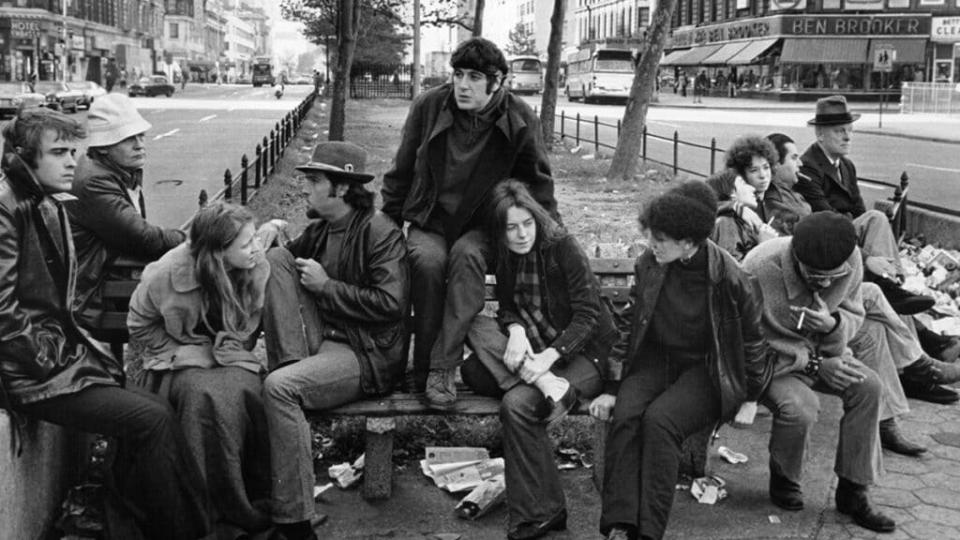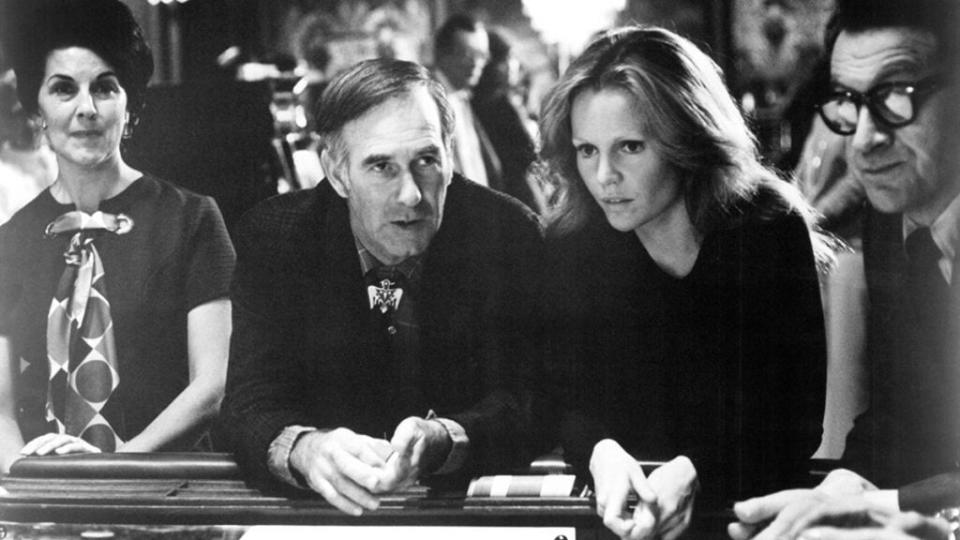Inside Joan Didion’s Entry Into Hollywood With Jim Morrison, Al Pacino and More
- Oops!Something went wrong.Please try again later.
- Oops!Something went wrong.Please try again later.
- Oops!Something went wrong.Please try again later.
- Oops!Something went wrong.Please try again later.
- Oops!Something went wrong.Please try again later.
- Oops!Something went wrong.Please try again later.
Having just produced the film version of Mart Crowley’s “The Boys in the Band,” Dominick Dunne looked forward to making a film with his brother, John, and his sister-in-law Joan Didion. The idea they all liked best was a film version of James Mills’ novel about a couple of young drug addicts on Manhattan’s rough Upper West Side. Didion summarized their film adaptation of “The Panic in Needle Park,” calling it “‘Romeo and Juliet’ on heroin.” It was the kind of short, snappy synopsis film executives loved and Didion delivered often in the early 1970s. The success in 1969 of such an offbeat hit as “Easy Rider” opened the door for another low-budget drug-themed movie, and the positive buzz on the Dunne-produced “Boys” helped, too.
Didion and the Dunne brothers’ ideas for casting their film were unorthodox but right in step with what Hollywood deemed hip in 1970. They wanted Jim Morrison of The Doors to make his screen debut as the drug addict Bobby in “The Panic in Needle Park.” Joan Didion and John Gregory Dunne had met Morrison when The Doors were recording their third album, “Waiting for the Sun,” at the Two Terrible Guys Studio near Sunset and Highland in Hollywood. Morris showed up late, belligerent, drugged and ready to set his much-inspected crotch on fire with a match. Didion, on assignment from The Saturday Evening Post, hoped to get an interview with the rock star. When Morrison proved incommunicative, she instead wrote an essay about the recording session for her book “The White Album.” She noted how The Doors talked to each other “from behind some disabling aphasia…. There was a sense that no one was going to leave the room, ever.”
Dominick Dunne secured a movie deal with Avco-Embassy, which had just released “The Graduate.” Even though the deal boasted a budget under $1 million, Dunne got the studio to put him up at the Volney Hotel, once home to Dorothy Parker, on East 74th Street in Manhattan. Since Didion and her husband were still working on the script, they took up residence at a much less desirable address, the Alamac Hotel, across Broadway and West 71st Street from Sherman Square, home to more addicts than trees and better known as Needle Park. Living at the seedy Alamac, they thought, would be part of their research.
The couple were on their way to being known as the Didions in Hollywood, much to John Gregory Dunne’s distress. Their friend Billy Hale, a major TV director, remembered their scouting Upper West Side locations for “The Panic in Needle Park.” “They went to Abercrombie & Fitch and bought all these jungle outfits. They were going into the heart of darkness. They took it very seriously,” he said. But not that seriously. They typically lunched on the other side of town at La Cote Basque.
Real panic struck when Avco-Embassy abruptly dumped the “Needle Park” project, and Dominick Dunne had to work overtime to negotiate a deal with Twentieth Century Fox and also try to hire a director. He much admired Jerry Schatzberg’s edgy “Puzzle of a Downfall Child,” starring newcomer Faye Dunaway. At the time, Schatzberg was better known for his fashion photography in Vogue.
“I read it with one eye and not much heart,” Schatzberg said of the Didions’s “Needle Park” script. What did excite him was a young actor whom Dominick Dunne wanted to cast after Jim Morrison proved too debauched (he died from a drug overdose in July 1971). The director had seen Al Pacino in the play “The Indian Wants the Bronx” and told his agent, “Boy, if ever I did a film, that’s the guy I’d like to work with.” Dominick also saw Pacino, but in another play, “Does a Tiger Wear a Necktie?”, and promptly thought of him to play Bobby in “Needle Park.”
“‘Al Pacino’ were the major words,” said Schatzberg. They were not major words, however, for the executives at Fox. Richard Zanuck and David Brown wanted another actor, one who was taller, better looking and better known. For a few weeks, Robert De Niro looked like a contender – although not a star, he had made one movie to Pacino’s none – but ultimately Pacino was cast.
Dominick Dunne proved to be superprotective of his relatives’ screenplay. “Nick got a little upset when he watched the dailies,” said Schatzberg. “His brother and sister-in-law wrote the script and maybe he was anxious about their seeing [the film]. I like the actors to improvise.”

Once shooting started in autumn 1970, the Los Angeles Herald-Examiner sent a reporter to do a story on the film. Bridget Byrne arrived around midnight for a shoot near the Museum of Natural History on Central Park West. Pacino told the reporter about the Method, his approach to acting. “When I have a scene in which I have to push [the character] Helen around, I push Kitty Winn around all day,” he said, then added, “Jerry doesn’t pretend to know anything about acting. But he has a sure instinct for what will work and what won’t, what looks right, what doesn’t.”
Dominick Dunne did not think such talk helped the film. Nor did John Gregory Dunne’s comment about New York City being a dying city, which was why he and his wife now lived in California.
“Needle Park” played the Cannes Film Festival, where Kitty Winn won the award for best actress on May 27, 1971. Al Pacino did not make the trip, having already started production on “The Godfather.” Schatzberg found the experience of having a film shown at Cannes to be part excitement, part humiliation. “We were put up at the Carlton a block away from the Palace – Nick, Kitty, Joan and John, and I came down. There was a big limo waiting for us. We drove one block and got out, and as we got out we saw the press running toward us.” Then the reporters ran right passed them; they were there to photograph and interview Michele Morgan, president of the Cannes jury.
“Needle Park” received an excellent reception from the assembled filmgoers, and their applause bathed the American team in adulation as they walked down the grand staircase at the Palais des Festivals. “Then when we got outside, there was no limo and we had to walk back to the Carlton,” Schatzberg recalled.
Next up for the Didions was the film version of her 1970 novel “Play It as It Lays,” also to be produced by Dominick Dunne. Ned Tanen at Universal Pictures agreed to greenlight the film because he personally liked the director Frank Perry, and the studio had done well with his previous movie, “Diary of a Mad Housewife.” Tanen, however, went on to call the novel “Play It as It Lays” and its screen adaptation “a piece of s—.”
Dominick Dunne, Frank Perry and the Didions visited all the locations in the book – the desert, the beach, the L.A. freeways – and they screened “The Pumpkin Eater” and “Petulia,” movies that “experimented with time,” said Perry. They then holed up in Dominick’s Spalding Drive apartment for four days, using a bulletin board and multicolored cards to chart the sequence of scenes.
The film launched the film career of Joel Schumacher, hired at $200 a week to design the costumes. “Nick introduced me to his brother and sister-in-law. They were fantastic to me,” said Schumacher. “They had this house on the beach in Trancas, and they had what would be called a salon. It was very international.” John Gregory Dunne knew people from Life and Time magazines, Joan Didion had written extensively for Vogue and Saturday Evening Post. “It wasn’t just movie people., which was unusual at that time. Back then it was such a tiny one-industry town. You didn’t meet people from outside the film business,” said Schumacher. “But at John and Joan’s, there were a lot of great reporters, people who were covering wars. It was an incredible mix of people.”
But mostly, it was movie people with whom the Didions wanted to network to secure script work. Those movie people included “Play It as It Lays” stars Tuesday Weld and Anthony Perkins, Julia and Michael Phillips, Martin Scorsese, Paul Newman and Joanne Woodward, Steven Spielberg, and a smattering of fellow screenwriters. Paul Schrader described the soirées in Trancas as being “very heady.” In addition to barbecuing, swimming, sunbathing, and talking about movie, “a lot of these writers and directors helped each other,” said Schrader. “Even though we were relatively unknown, there was a real feeling that the world was our oyster.”
That heady mix at the Didions’ salons, however, did not include Dominick Dunne. “They invited me to their house at least once every other week,” said Schumacher. “Nick was never invited. Something was going on.” It had been going on since they lived together as brothers on Albany Avenue in West Hartford. Despite their seven-year age difference, Dominick resented John calling himself “Dad’s favorite son,” and worse, it was true. That father liked John’s “cheekiness” and he hated Dominick’s being a “sissy.”

Dominick Dunne later remarked how he got along great with his brother and sister-in-law on “The Panic in Needle Park” but “Play It as It Lays” was another story. He felt he had made valuable suggestions for the “Needle Park” script, as well as “Play It as It Lays.” The Didions, however, were not interested in his ideas. In turn, the couple began to worry about Dominick’s increasing substance abuse and how it adversely affected his reputation in Hollywood – and, by association, theirs.
Tanen’s hatred of “Play It as It Lays” only grew when he started seeing rushes. He called it Didion “vomiting up her life.” Regardless, the film was released in October 1972. Major critics like Vincent Canby in the New York Times and Charles Champlin in the Los Angeles Times liked it, but Stanley Kauffmann in the New Republic and Pauline Kael in the New Yorker called it a pretentious bore. Dominick Dunne described it as having “won an award at the Venice Film Festival, but only ten people saw it. It was that kind of picture.”
After the film’s release, Dominick Dunne finally confronted Joan Didion about his being the prototype for the BZ character played by Anthony Perkins. BZ is a homosexual but closeted movie producer who commits suicide by swallowing a handful of pills or, as Didion wrote it, “a queen’s way of doing it.” The novelist told her brother-in-law no: the character was based on a man they both knew who, in Dominick’s opinion, bore no resemblance whatsoever to a closeted, suicidal movie producer. Dominick later admitted he should have seen the similarities between himself and BZ as soon as he first read the novel. He always had a “masseur to lunch,” just as BZ does. But he chose not to see.
As for Didion, she took a jaundiced view of the filmmaking process that brought “The Panic of Needle Park” and “Play It as It Lays” to the screen. In “The White Album,” published at the end of the decade, she wrote how studio executives back in 1970 were “narcotized by ‘Easy Rider’s’ grosses,” and criticized them for thinking “all that was needed to get a picture off the ground was the suggestion of a $750,000 budget…and this terrific 23-year-old kid director.”
This article is excerpted from Robert Hofler’s book “Money, Murder, and Dominick Dunne: A Life in Several Acts,” published by the University of Wisconsin Press. Copyright c 2017 Robert Hofler

